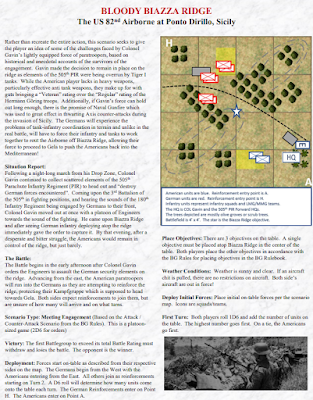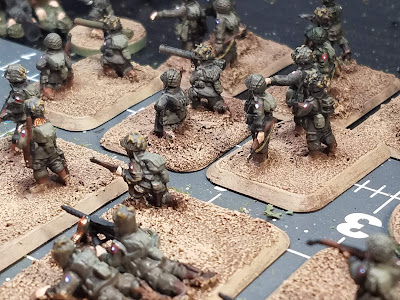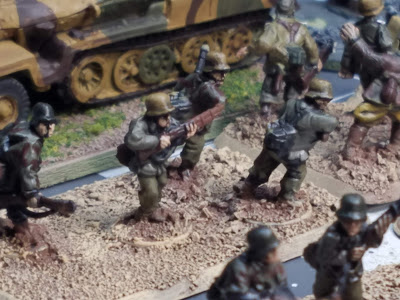On Sunday afternoon I sat down for a solo playtest of the Biazza Ridge scenario that was posted here recently featuring my newly painted 82nd Airborne troopers and my Hermann Goering Division troops. The rules used were the Battlegroup series of rules.
The result was a high-octane shootout with almost no place on the table to hide. Each side, at murderously close quarters, was able to bring their unique weapons systems to bear against the other.
 |
| view from the American side. COL Gavin is behind the small house in the lower right while the Germans are in the vicinity of the bombed out church in the upper left. |
While this sounds outrageously fun for a tabletop wargame, there were some lessons learned and key take-aways. Ever wondered how a Tiger tank would fare against a 14 inch naval shell? How about how a 75mm "Pack" howitzer stands up to an 88mm HE shell fired from a Tiger tank? If you can answer yes to any of those questions, you're going to love this post...
The game started out as planned, with both sides practically in range of their placed objectives. The Germans won the initiative and began, almost instantly forcing an American chit-pull for the center and the German side objective. The HG troopers fanned out onto both ridges while the Americans maneuvered a section into a wheatfield on their side of the ridge. With only a .30 caliber MMG team, a rifle section, and an elite Engineer squad to counter almost a platoon of HG troops, this would be tough. The Americans set up a base of fire, and headed for the ridge.
 |
| COL Gavin with some of his commo troops at the release point where American reinforcements are arriving. |
 |
| A US MMG team puts some fire down against the ridge where they can see Germans skulking around |
 |
| Meanwhile on the other side of the hill, the Germans are getting into position. Here we see an LMG team and a rifle team from the HG Division getting into place! |
The German and American reinforcement rolls begin on turn 2, and both sides begin feeding their arriving reserves into the fight. Remember, the American artillery and naval gunfire is the last thing to arrive, as is the German armor. Both sides must bring on all of their infantry reinforcements first, before any of the heavy stuff.
 |
| Germans at the church objective - an EPIC: Armageddon Order Die! |
 |
| And Germans at the center objective on the ridge, in the olive grove |
The Americans open fire with their .30 cal section while a rifle team moves around to their left to counter the Germans on the ridge. It looks like this will be a fight for the ridgeline for the Americans as the Germans moved first.
 |
| Germans taking fire almost immediately from the Americans in the 10-20" range bracket, which is a 4+ to hit!!! It only gets worse from there. |
 |
| German platoon commander enters the table. |
 |
| The Americans get the worst of a rough firefight with the HG troopers. I would eventually pull this 9 man paratrooper section back in order to preserve the force and not pull a chit. |
 |
| COL Gavin urges the oncoming men from the 3rd Battalion, 505th to take the ridge. |
It's worth mentioning here that in the brutal close quarters, the Engineers from the 82nd were sent to the ridge and blunder into close combat with the HG troopers. They did not use an assault/charge order so it's simply shooting on the 0-5" column which counts every hit except a 1 (brutal) The Germans will rally and counterattack, but their small 3 man LMG team gets the worst of things and the German team is destroyed in the counterattack.
 |
| The American para-engineers are stunned to find Germans on the ridge! They maneuver and fire at close range. |
 |
| The Germans are just as stunned to see them and immediately maneuver and counter attack (beyond the call of duty!) They assault and cause heavy casualties and are themselves destroyed inthe process. |
By now all of the US infantry reinforcements are on the table and the Pack Howitzers are coming on. Gavin's mobile artillery towed by jeeps take up positions next to the initial .30 caliber MMG position and are being used like AT guns from cover. The teams can hear armor over the cacophony of small arms and LMG fire....
 |
| A flood of US reinforcements being sent immediately into the fight. There is a definite see-saw nature to this fighting. A side sends up a team or squad, it gets chewed up, destroyed, and the other side sends up another in its place. |
 |
| The howitzers show up next |
 |
| US FO spotting for mortars. They plop a mortar fire mission directly into the church! Also note the US .30 cal team behind the copse. They're watching the eastern hilltop while the US reinforcements move up. |
Reinforcements, including the Pack Howitzers are starting to get into position, and German Armor is approaching so it's literally perfect timing.
 |
| Pack Howitzer sections and the Navy forward observers are on site. Gavin rushes them into position. Note the dice are what I'm using to track orders. |
 |
| UNLIMBER!! Gavin muses it's just like the Civil War - direct fire cannons. |
 |
| MEDIC! A US medic rushes into position. He's greatly needed on the American left where things aren't going so well. Worth mentioning that he saved a number of "hits" from becoming "hits" on Sunday. |
 |
| MORTAR FIRE MISSION! I forgot completely how to adjudicate light mortars - is it direct HE fire? Is it indirect? Is it both? I dont want to ask on the FB forum because I'm not looking to be ridiculed or mocked by that crew. Anyways I used direct HE fire because you can clearly see the church. That's their aiming point. ROE be damned! |
 |
| Navy Beach Battalion personnel! |
 |
| US MMG team ascending the ridge. |
 |
| US infantry holding the ridge down. The Germans are to their front, behind the bend. They cautiously advance... |
 |
| The unmistakable sound of gearboxes and sprockets turning as a Panzer III and a halftrack show up. |
 |
| Meanwhile the 251/3 command post represents the FWD HQs for the German force, enabling them +1 orders. |
 |
| The mortars are hammering the Germans in the church. |
 |
| Germans move out to the ridge as they see more Americans coming up. |
 |
| Speaking of Americans, a full squad is occupying the ridge now. You can barely make out reinforcing Germans in the upper left... |
The game is at an interesting point now. Both sides are about halfway to their breakpoint, but are critically short of infantry. All of the US squads have suffered attrition, and the Forward Observer, Naval Gunfire Team, and Pack Howitzers are getting into position. The US has a tenuous hold on the ridges but without much strength to back it up. The Germans have a single squad in reserve attempting to push the US troops off. The Germans are also setting up a heavy mortar which spells big trouble for the US support troops in the open. Just then...the Tigers show up!
 |
| Tigers rumble down the road, straight towards the Americans. The Pack Howitzer crews leap into action. ACTION FRONT! |
 |
| Advancing alongside the final infantry reserves, the Tigers push forward at top speed. Their turrets traversing, looking targets but coming up short! |
 |
| Meanwhile, the HG troopers move out to push the Americans back off the ridge, confident that the arrival of the Tigers will bring victory! |
The American Pack howitzers, with absolutely no hope of knocking out the Tigers, fire and one scores a hit! The resulting morale check pins the tiger, clearly stunning the crew. The Americans know that now is the time to call in Artillery fire. The comms check fails, and the re-roll from the comms relay team also fails! This is bad! The next German turn brings the turrets laid straight onto the Pack Howitzers. An HE hit vaporizes 2 x crewmembers but miraculously, the gun is still not pinned. The Germans zero in with a tripod-mounted MG42 and make short work of the remaining crew, but there is still one remaining howitzer!
The Americans know it's now or never on their turn. The naval liaison team goes to work. They amazingly pass their comms check! The spotting round only deviates 6" and it's FIRE FOR EFFECT. The 14" shells tear down into the valley, pinning Germans and Americans alike, who are glued into their slit trenches. One direct hit against the Tiger 1 which is ripped open like a tin can (i laid it on its side like the iconic photo of the action after the Biazza Ridge fight!). The other Tiger is pinned, as are a host of other American fireteams after the huge shells ripped the hillside apart. The BP is about even here, 17 American to 18 German, and I call the game as it's a work night and I had to pack up.
Scenario Thoughts
Well, Battlegroup gave a good game. Lots of unexpected occurrences and I appreciate that. With the "small" amount of forces this game was very manageable, even with all of the things you have to manage. I did run into some issues which I want to cover here, though. These were more issues with the scenario than the rules.
The Battle Area: The battle area was too small (4 x 4) for what I was trying to accomplish in it. Granted, it was a smaller force, but the infantry weapons ranged almost the entire field, and with the "olive groves" being really light vegetation, they didn't hinder line of sight in the game, they just afforded a soft cover save to troops in them. That meant you could target much of an enemy advancing against you from the comfort of your own baseline, as both the Americans and Germans did with their support weapons. In many cases, the game turned into a shooting gallery. There are some remedies I'm thinking of here - namely to enforce a sort of "crest" rule on the ridgeline, and potentially make the olive grove thicker so you cant range inside the entire feature from everywhere on the table. The main point for this, though, is to expand the play area to 6 x 4.
Objectives: Another by-product of the smaller battle area were the proximity of the enemy to the objectives, which changed hands a few times during the game. First of all, I've never played a Battlegroup game, or at least played very few, where all of the objectives were secured. In this game, not only were they all secured, but the ridgeline objective, which seemed to gobble up both German and American units, changed hands at least 3 times. That was alot of fun, but most likely was a by-product of the smaller table.
Better Defining the Terrain and Restrictions: I found myself thinking about the olive groves alot during the game, and felt that they should have provided a bit better cover and concealment to the troops within them. Battlegroup is fairly loose on terrain effects so this is a bit more on me to define in this instance. Not impossible, but I'll need to put some thought into it.
Infantry Attrition: Due to the super-shooty nature of the game (I attribute this to the confined space of the 4 x 4 table and open lines of sight) the infantry casualties were horrendous and almost disproportionate to the battle rating. For instance when the game ended we were a bit over half BR for both sides, but both sides had taken heavy casualties with their infantry forces, and there was not a fireteam or MMG team on the table that had not yet been bruised or battered, and we were still a good ways away from the BP of 29 or 32. I wondered about that as I had not run into that problem with Battlegroup before, and I had played on even more open tables than this (albeit with lots more armor).
Rules Involvement: I've always liked the BG rules but they can be very involved, especially for someone who hasnt played in awhile. In this instance, looking up the procedures for various mechanisms was taxing. Granted, most of my questions were answered (except light mortars) by the rulebook, there was quite a bit of looking things up to make sure I was playing correctly. Also without someone else, there's twice the work to do when playing.
The bottom line is that this game was a ton of fun with all of the ordnance you could want from bazookas and pack howitzers up to 88mm guns and naval gunfire! What is not to love there? That said, I am still wondering how the game would play with different rules sets and am inclined to play with other rules sets to see how the game goes. Rapid Fire Reloaded comes to mind, as does Flames of War or Norm's "Tigers at Caen" or something similar. So there is clearly a bunch of work before the scenario is ready for "prime time" to be played at a convention, but it's getting there.
If you play this battle, with any rules set really, I would love to know how it worked out for you!














































